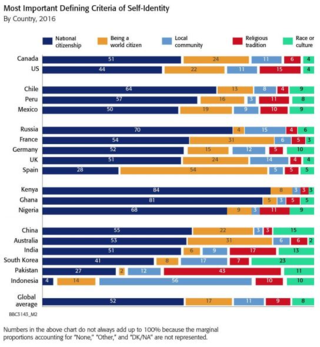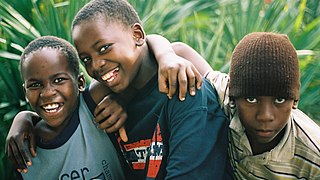
The Immigration and Nationality Act of 1965, also known as the Hart–Celler Act and more recently as the 1965 Immigration Act, is a landmark federal law passed by the 89th United States Congress and signed into law by President Lyndon B. Johnson. The law abolished the National Origins Formula, which had been the basis of U.S. immigration policy since the 1920s. The act formally removed de facto discrimination against Southern and Eastern Europeans as well as Asians, in addition to other non-Western and Northern European ethnic groups from the immigration policy of the United States.

Afro-Asians, African Asians, Afrasians or simply Black Asians, often referred to as "Blasians", are persons of mixed Asian and African ancestry. Historically, Afro-Asian populations have been marginalised as a result of human migration and social conflict.
Since 1945, immigration to the United Kingdom, controlled by British immigration law and to an extent by British nationality law, has been significant, in particular from the Republic of Ireland and from the former British Empire, especially India, Bangladesh, Pakistan, the Caribbean, South Africa, Nigeria, Ghana, Kenya, and Hong Kong. Since the accession of the UK to the European Communities in the 1970s and the creation of the EU in the early 1990s, immigrants relocated from member states of the European Union, exercising one of the European Union's Four Freedoms. In 2021, since Brexit came into effect, previous EU citizenship's right to newly move to and reside in the UK on a permanent basis does not apply anymore. A smaller number have come as asylum seekers seeking protection as refugees under the United Nations 1951 Refugee Convention.
Goffals or Coloured Zimbabweans are persons of mixed race, predominately those claiming both European and African descent, in Malawi, Zambia, and, particularly Zimbabwe. They are generally known as Coloureds, though the term Goffal is used by some in the Coloured community to refer to themselves, though this does not refer to the mixed-race community in nearby South Africa. The community includes many diverse constituents of Shona, Northern Ndebele, Bemba, Fengu, British, Afrikaner, Cape Coloured, Cape Malay and less commonly Portuguese, Greek, Goan, and Indian descent. Similar mixed-race communities exist throughout Southern Africa, notably the Cape Coloureds of South Africa.

According to the 2021 Canadian census, immigrants in Canada number 8.3 million persons and make up approximately 23 percent of Canada's total population. This represents the eighth-largest immigrant population in the world, while the proportion represents one of the highest ratios for industrialized Western countries.
The War Brides Act was enacted to allow alien spouses, natural children, and adopted children of members of the United States Armed Forces, "if admissible," to enter the U.S. as non-quota immigrants after World War II. More than 100,000 entered the United States under this Act and its extensions and amendments until it expired in December 1948. The War Brides Act was a part of new approach to immigration law that focused on family reunification over racial exclusion. There were still racial limits that existed particularly against Asian populations, and Chinese spouses were the only Asian nationality that qualified to be brought to the United States under the act. Additionally, the War Brides Act was well supported and easily passed because family members of servicemen were the recipients, but there were concerns over marital fraud which caused some tensions.

Illegal immigration is the migration of people into a country in violation of the immigration laws of that country or the continuous residence without the legal right to live in that country. Illegal immigration tends to be financially upward, from poorer to richer countries. Illegal residence in another country creates the risk of detention, deportation, and/or other sanctions.
Immigration to South Korea is low due to restrictive immigration policies resulting from strong opposition to immigrants from the general Korean public. However, in recent years the influx of immigrants into South Korea has been on the rise, with foreign residents accounting for 4.9% of the total population in 2019. According to the United Nations, in 2019 foreign born residents represented 2.3% of the total population, which is below the world average of 3.5%.
Filipinos in South Korea have a history dating back to the establishment of South Korea. Many live in Seoul, where they gather in the Hyehwa-dong and Dongsung-dong areas of Jongno-gu.

In South Korea, immigration policy is handled by the immigration services of the Ministry of Justice, Ministry of Labor, Ministry of Health and Welfare and the Ministry of Foreign Affairs and Trade. The Nationality Act, Immigration Control Act, Multicultural Families Support Act, and the Framework Act on Treatment of Foreigners are the foundations of immigration policy in Korea. The Korean government initiated a discussion in 2003 on establishing an independent immigration office to accommodate fast-growing immigrant and to prepare inclusive and rational immigration policies; however, there has been little progress. The Foreigner Policy Committee, headed by the Prime Minister, coordinates foreigner-related policies which were handled by many ministries. However, its role is limited because of a shortage of resources and manpower. The establishment of an Immigration Office is expected to solve these problems by concentrating all related resources and manpower under one umbrella.
Afghans in Iran are citizens of Afghanistan who are temporarily residing in Iran as refugees or asylum seekers. They form the largest percent of the Afghan diaspora. The first wave of Afghans were admitted to Iran after the start of the Soviet–Afghan War in 1979.

Korean ethnic nationalism, or Korean racial nationalism, is a racist, chauvinist and ethnosupremacist political ideology and a form of ethnic and racial identity that is widely prevalent by the Korean people in Korea, particularly in South Korea. It is based on the belief that Koreans form a nation, a race, and an ethnic group that shares a unified bloodline and a distinct culture. It is centered on the notion of the minjok, a term that had been coined in Imperial Japan ("minzoku") in the early Meiji period. Minjok has been translated as "nation", "people", "ethnic group", "race", and "race-nation".
Racism in South Korea comprises negative attitudes and views on race or ethnicity which are related to each other, are held by various people and groups in South Korea, and have been reflected in discriminatory laws, practices and actions at various times in the history of South Korea against racial or ethnic groups. It has been recognized as a widespread social problem in the country. South Korea lacks an anti-discrimination law, which was recommended by the UN Human Rights Committee in 2015. The law has been reported stalled due to "lack of public consensus".
In the United States, members of the same immigrant family often have differing access to resources. Much literature focuses on inequality between families, but inequality often exists within families as well. Though within-family inequality is not unique to immigrant families, the processes of migration and assimilation into American society provide new channels through which such inequality may emerge.

Nearly half of all refugees are children, and almost one in three children living outside their country of birth is a refugee. These numbers encompass children whose refugee status has been formally confirmed, as well as children in refugee-like situations.

According to the Japanese Ministry of Justice, the number of foreign residents in Japan has steadily increased in the post Second World War period, and the number of foreign residents was more than 2.76 million at the end of 2022. Being a country with a total estimated population of 125.57 million in 2020, the resident foreign population in Japan amounts to approximately 2.29% of the total population.

Immigrants make up about 13% of the US population, about 42 million out of a total population of 318.9 million citizens in 2017. First and second generation immigrant children have become the fastest-growing segment of the United States population. Compared to the native-born population, young adults aged 15–34 are significantly over-represented in new immigrants. Children and immigrants ages 35–44 are in similar proportion to native-born Americans, but older people are under-represented in new immigrants.
The rate of youth unemployment in South Korea fluctuated in the 9–11% range between 2001 and 2014. It was above 10% in 2018 and down to 7.1% by the end of 2019 - the lowest level since 2011.
Federal policy oversees and regulates immigration to the United States and citizenship of the United States. The United States Congress has authority over immigration policy in the United States, and it delegates enforcement to the Department of Homeland Security. Historically, the United States went through a period of loose immigration policy in the early-19th century followed by a period of strict immigration policy in the late-19th and early-20th centuries. Policy areas related to the immigration process include visa policy, asylum policy, and naturalization policy. Policy areas related to illegal immigration include deferral policy and removal policy.

Asian Australian history is the history of Asian ethnic and racial groups in Australia who trace their ancestry to Asia. The term Asian Australian, was first used in the 1950s by European Australians who wanted to strengthen diplomatic and trade ties with Asia for the benefit of the Australian community. The term was not originally used to describe or recognise the experiences of people of Asian descent living in Australia. It was only in the late 1980s and 1990s that the term "Asian Australian" was adopted and used by Asian Australians themselves to discuss issues related to racial vilification and discrimination. Today, the term "Asian Australian" is widely accepted and used to refer to people of Asian descent who are citizens or residents of Australia, though its usage and meaning may vary within the Asian Australian community.












